Indoors and outdoors, with little material to begin: some primary colors, brushes, paper, pencils will be enough to enter the circle of watercolorists.
Being introduced to a new technique is always rewarding, so if you want to know how to paint with watercolor, follow our guide, it tells you (almost) everything!
Contents
- Zoom on the necessary material to start painting in watercolor
- Choose watercolor, in cup or tube
- Use brushes for watercolor
- Opt for a quality paper
- Add some material to your watercolor kit
- Prepare the paper before painting in watercolor
- Start your first wash
- Make your first watercolor drawing
- Maintain your brushes
Zoom on the necessary material to start painting in watercolor
No need to invest in very high-quality content before knowing if you will continue your watercolor business. Start with quality of painting “student” before directing you towards an excellent quality to extra-fine, the extra-fine quality being very rich in pure pigments and therefore more expensive. Some brushes of average but correct quality and paper of good quality are enough to constitute your kit “beginner.”
To the primary material, add paper towels or a sponge, some pencils to make the sketches, an eraser, two jars for water and a bag to carry/store everything if you want.
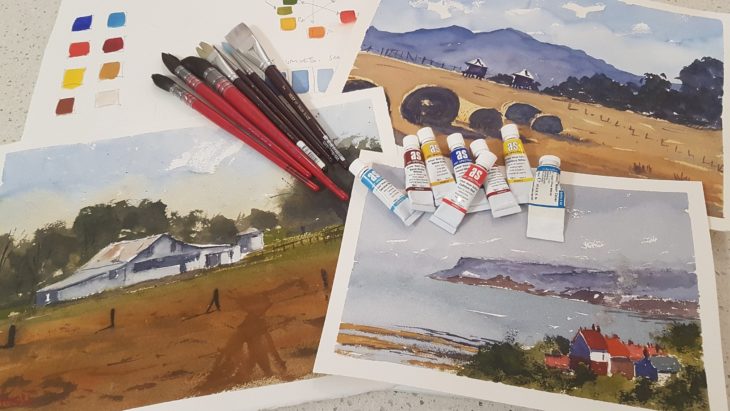
Source: Learn To Paint Academy
Note: a 1 cm thick plywood shelf can be used as a worktop, but it is not essential.
Choose watercolor, in cup or tube
Watercolor painting comes in two forms:
Bucket: the color is pressed in a small rectangular container, bucket or half-bucket, the latter being convenient to take your equipment outside or for the colors little used.
In tube: rich in pigments, diluting well enough, tube painting can cover larger surfaces, make substantial areas, bring a touch of intense color and of course use the technique of washing on large surfaces, the base of the ‘watercolor.
So, bucket or tube? It’s up to you to see what suits you best, but a good compromise is a metal box with 24 slots including 12 color buckets + 12 empty slots to mix your colors and add them.
Add three tubes of primary colors to make your colors: magenta, cyan, blue and yellow.
More challenging to dilute than the tube, the bucket is ideal for small tables, sketches, and details.
Tip: for color mixing, you can get a color wheel, cardboard on which you see all the possible mixes from the three primary colors.
Use brushes for watercolor
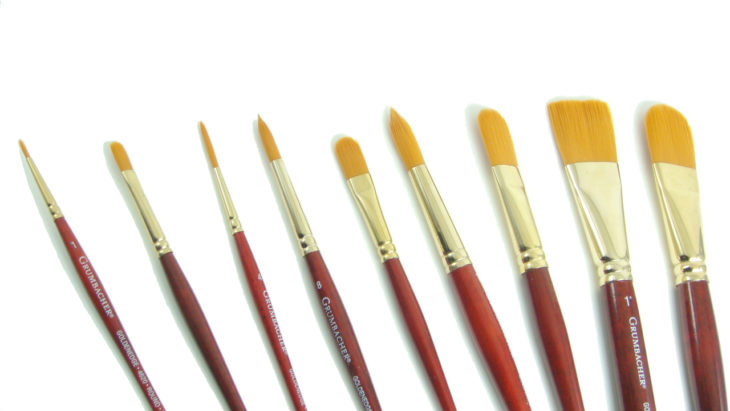
Source: Flax Art
Brushes are usually made of animal hair such as marten, pork, squirrel, but their cost is quickly prohibitive. Opt for synthetic brushes.
Note: The size of the round brushes is expressed in numbers, from the smallest to the largest: # 0 to # 24. Flat brushes are sorted by width, which may be a bit different depending on the manufacturers.
To get started, choose two types of brushes:
The round brushes: they allow realizing as well the small washings as the details. Take three brushes of different sizes: # 3, # 6, # 8 or # 10, for example, depending on what you is going to paint.
The flat brushes: they are used to realize precise forms, to make chiseled, to wet the paper and of course for the washings in case of the big surface. Take a brush 2 to 3 cm wide.
Watercolor pencil: You can even use watercolor pencils to avoid liquid color problem. You can choose the perfect watercolor pencils from bestforconsumer.com if you need for painting.
Good to know: for your wash and wet paper, you can use a damp brush.
Opt for a quality paper
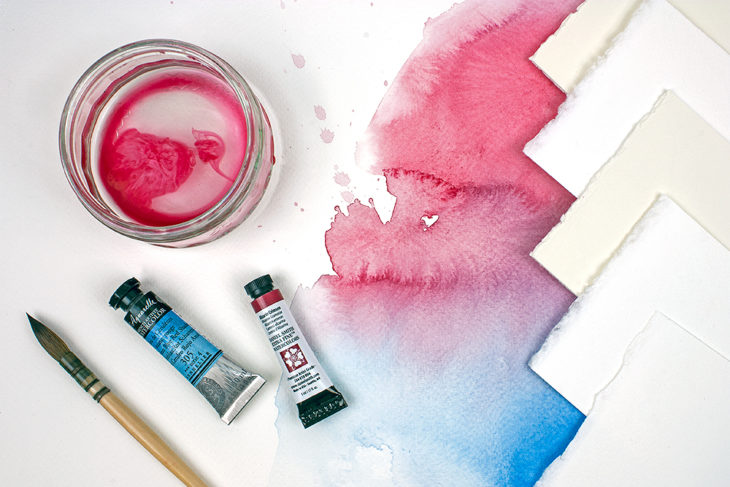
Source: Ken Bromley Art Supplies
The papers used to paint with watercolor are chosen according to their surface condition and according to their thickness/grammage, namely:
- Fine-grain: the texture is a bit granular; the absorption is fast. This paper is commonly used because it is versatile.
- Grosgrain: somewhat granular, the absorption is slow. It is not suitable for detailed drawings, but it supports the effects of color and texture.
- Satin grain: smooth, absorption is fast. Perfect for details, for card use.
- Grain torching: looks like a paper with a texture “cloud” whose absorption is slow — a little more comfortable to work than the big grain.
- The grammage: the paper is measured in grams per square meter. A beginner will favor the 300 g / m². The most used are the 200 g / m², 300 g / m², 410 g / m².
Note: All formats are possible but prefer small ones, knowing that there are blocks and flying sheets that must be fixed on a worktop.
Add some material to your watercolor kit
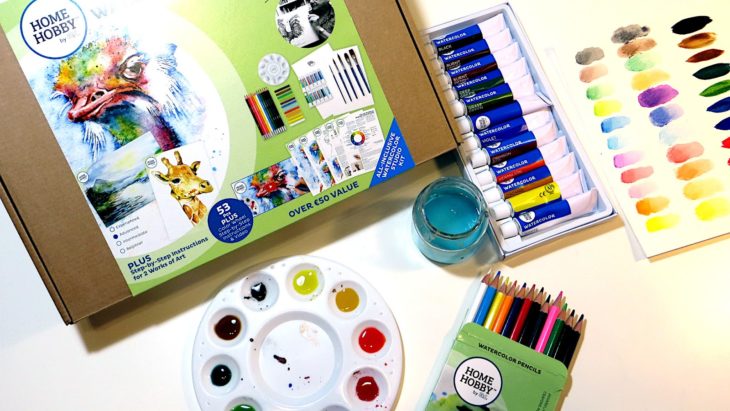
Source: Ivy Lily Creative
Complete your equipment with graphite pencils, HB, B, 2B. They are easy to erase and do not leave too much traces.
They will be used to make sketches but also to draw some details and shadows.
Add some watercolor pencils that, when wet, dilute the colors and provide a wash effect.
Prepare the paper before painting in watercolor
The lightweight papers can stretch and curl under the action of water, which complicates the application of watercolor and drying.
You can remedy this by preparing the paper using a straightforward technique:
- Prepare a sheet of plywood or MDF (or medium, wood fiberboard) at least 5 cm larger than the paper.
- Cut four strips of gummed kraft 10 cm larger than the width and length of the paper.
- Attach a perfectly flat piece of oilcloth to the plywood with thumbtacks.
- Wet the paper with a sponge on both sides or soak the paper in a bowl by removing it immediately and allowing it to drip for a few moments.
- Place the paper on the oilcloth and stick the gummed kraft on 1 cm of the paper along the edges, after wetting the adhesive side with a sponge.
- Let the paper dry in a ventilated room. It will no longer curl under the action of water!
Start your first wash
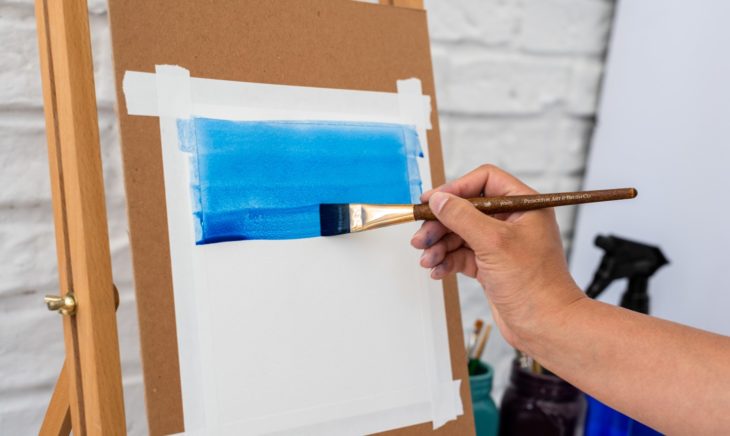
Source: Bluprint
Before you start painting, put a drop of water in the chosen cup and let the dough absorb it for a few minutes.
Place your work surface slightly inclined, for example, by placing it on two wooden wedges or books.
Prepare a pot of water and a wet sponge next to you.
Pin your leaf on the surface, put the sponge on the sheet in vertical or horizontal stripes, wet the bristles of your brush and make your wash as follows:
- Pass the brush several times over the color to load it.
- Start from the top left or right, depending on whether you are right-handed or left-handed, and drop the paint across the entire width of the paper.
- Wet the brush, load it in color and make a second band by touching the first to recover the color of the first band.
- Do this to the bottom of your sheet and let it dry.
Tip: Work quickly and methodically. You can wet more or less the sheet and soak more or less your brush. Try to judge different effects.
Make your first watercolor drawing
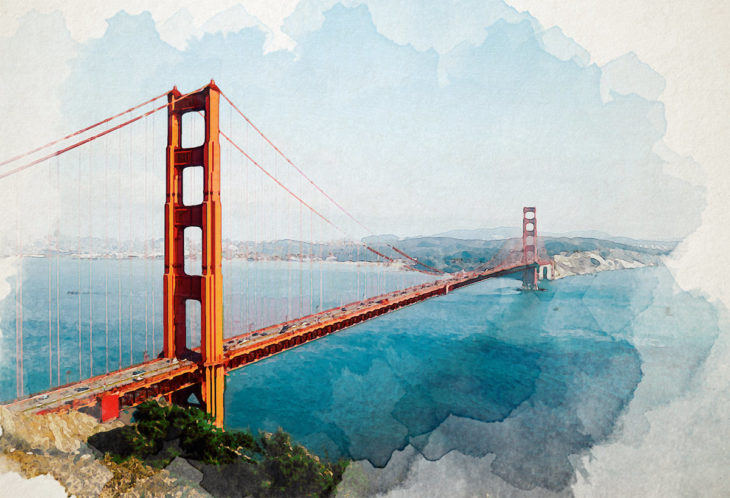
Source: Spoon Graphics
The technique of watercolor consists of superimposing wash or layers of paint more or less diluted going from the lightest to the darkest while keeping unpainted spaces (white) to highlight the light in your drawing.
- Use a 2B pencil to draw your sketch and be very light on the line. If you are working on a wet paper, you will not be able to erase or little afterward.
- Fill your drawing with your colors and do not hesitate to more or less wet to judge the possibilities of the watercolor.
- To preserve white areas, absorb the color with a cotton swab or a cloth wrapped around a finger.
- The more you want to blur, the more you have to wet the paper as you draw, allowing it to dry between layers for overlays or leaving wet for blending.
- For shadows, you can work dry or almost dry, or use a pencil or watercolor.
- When your drawing is finished, if it is too vague or imprecise, you can use an intense color to emphasize specific details to give relief to the whole.
- If your sketch has some imperfections, pass a watercolor pencil over the pencil line of the plan to hide it.
Maintain your brushes
- To keep your brushes in good condition for a long time, care must be taken for that:
- Use warm water and a little soap when painting at home, or clean with clear water when outdoors. Immediately after, squeeze the hair with a paper towel.
Put your brushes flat after replacing the tuft and tip between your thumb and forefinger.
